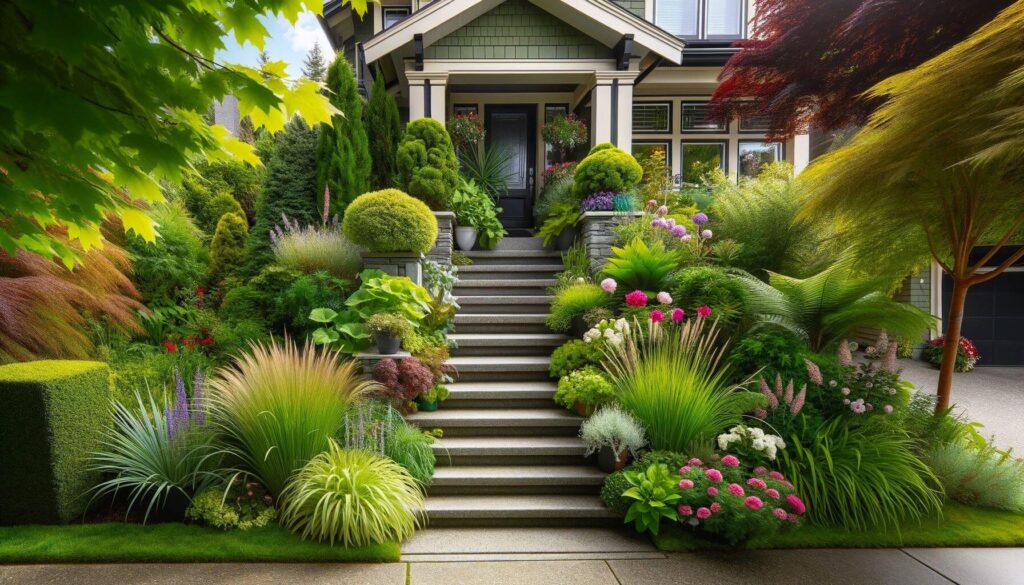
Front steps create the first impression of your home, setting the tone for what lies beyond. Brick front steps design combine timeless beauty with durability, making them perfect for creating welcoming entryways.
Understanding Brick Step Fundamentals
The foundation of beautiful brick steps starts with proper design and material selection. Taking inspiration from unique front step designs, homeowners can create entrances that complement their architecture. The choice of brick color, texture, and pattern establishes the visual foundation.
Traditional red clay bricks offer classic appeal, while modern variations include mixed colors and finishes. The size and shape of bricks influence both aesthetics and functionality. Consider how different brick arrangements create unique visual effects.

When planning brick steps, think about how they connect to existing stone accents for entryways. This integration ensures a cohesive look that enhances overall curb appeal.
Incorporating Safety Features
Safety remains paramount in front step design. Proper tread depth and riser height ensure comfortable, secure steps. Many homeowners integrate lighting elements similar to modern living room lighting principles for enhanced visibility.
Non-slip surfaces become especially important in wet conditions. Consider textured brick finishes or specialized treatments that improve traction. Strategic placement of handrails adds both safety and architectural interest.
Think about drainage solutions that prevent water accumulation. Slight slopes and proper joint spacing help water flow away from steps naturally.
Blending with Architectural Styles
Brick steps should complement your home’s architectural character. For homes with traditional elements, consider designs that match exterior modern deck spiral stairs aesthetics. The key lies in finding harmony between different exterior elements.
Modern homes might feature clean lines and minimalist brick patterns. Traditional homes often benefit from more elaborate designs with detailed brickwork. Consider how your steps can bridge different architectural elements.
The transition between steps and surrounding landscaping deserves careful attention. Well-designed steps create natural flow between different outdoor spaces.
Landscaping Integration

Thoughtful landscaping transforms brick steps into garden focal points. Consider how front yard landscape fountain features might complement your steps. Water elements create pleasant sounds while adding visual interest.
Plant choices should enhance rather than overwhelm step design. Low-growing plants soften edges while maintaining clear pathways. Consider how seasonal changes affect the overall appearance.
Many homeowners incorporate stunning driveway landscaping ideas to create seamless transitions. The goal involves unifying different outdoor elements into a cohesive design.
Material Combinations
Combining brick with other materials adds visual interest and functionality. Taking cues from masonry elements outdoor office space, designers often pair brick with natural stone or concrete.
Consider how different materials affect both appearance and maintenance needs. Metal railings provide necessary safety while adding contemporary flair. Wood elements bring warmth to brick step designs.
The key lies in choosing complementary materials that enhance overall design. Color coordination and texture combinations create sophisticated, layered appearances.
Lighting Design Strategies
Proper lighting enhances both safety and aesthetics of brick steps. Drawing inspiration from interior stone accent wall ideas, designers incorporate various lighting techniques.
Built-in step lights provide subtle illumination without detracting from design. Consider how different lighting angles highlight architectural details. Timer-controlled systems ensure consistent evening illumination.
Path lights and landscape lighting work together to create welcoming approaches. The goal involves balancing practical illumination with aesthetic appeal.
Seasonal Maintenance

Brick steps require specific care through changing seasons. Winter demands particular attention to prevent ice accumulation and salt damage. Regular cleaning preserves both appearance and safety.
Consider how waterproof flooring for screened porch principles might apply to step protection. Proper sealing helps prevent moisture damage and extends longevity.
Seasonal inspections identify potential issues before they become problems. Prompt repairs maintain both safety and aesthetic appeal.
Design for All Seasons
Year-round functionality influences successful step design. Winter safety features might include built-in heating elements or covered portions. Summer designs often incorporate shade elements and cooling features.
Consider how ways to boost your homes curb appeal through seasonal decorations. Adaptable designs accommodate different seasonal needs while maintaining visual appeal.
Think about how weather patterns affect step usage throughout the year. Design elements should enhance functionality in all conditions.
Custom Details and Accents
Personalized touches make brick steps unique to each home. Consider incorporating family crests, house numbers, or decorative inlays. These details add character while maintaining classic appeal.
Drawing inspiration from concrete slab designs ideas, designers often include custom patterns or borders. These elements create visual interest without overwhelming the basic design.
Think about how custom features might enhance both functionality and aesthetics. Personal touches should complement rather than compete with overall design.
Creating Welcoming Transitions

Front steps should invite visitors while easing the transition from outdoors to inside. Consider how entryway mirror with shelf concepts might inspire landing designs.
Landing areas provide space for greeting guests or setting down packages. Consider how different step configurations affect traffic flow and social interaction.
Think about creating comfortable transitions between different elevation changes. Well-designed steps make height differences feel natural and effortless.
Environmental Considerations
Sustainable design practices enhance long-term value and environmental responsibility. Consider water runoff management and permeable design options. These features protect both your property and local environment.
Natural materials and local sourcing reduce environmental impact. Think about how design choices affect long-term sustainability and maintenance needs.
Consider incorporating eco-friendly features like rain gardens or native plants. These elements enhance both appearance and environmental benefits.
Scale and Proportion
Successful step designs maintain proper relationships between various elements. Consider how step width relates to your home’s entrance and overall facade. Proportional designs create harmonious visual connections.
Think about how different step configurations affect visual weight and balance. Wider steps might suit grand entrances while narrower designs work better for casual side entries.
Consider how step design relates to overall property scale. Well-proportioned steps enhance rather than overwhelm surrounding features.



